Flanged intrascleral IOL fixation with double-needle technique
The haptics of the IOL are fixed to the sclera without suture or glue.
The intrascleral IOL fixation technique was reported by Scharioth and Agarwal as a sutureless technique for IOL fixation. This technique has become a popular procedure because it has some advantages over conventional trans-scleral suturing of the IOL. Flanged IOL fixation is a new surgical procedure that can be carried out via the conjunctiva in which the haptics of the IOL are strongly fixed to the sclera without using suture or glue. This technique is simple but not easy. The surgeon needs to understand some key points of the technique.
Yamane intrascleral IOL fixation technique
The Yamane intrascleral IOL fixation technique follows these steps:
1. Pars plana vitrectomy or anterior vitrectomy.
2. Subluxated crystalline lens or dislocated IOL removal.
3. Three-piece IOL insertion into the anterior chamber. The trailing haptic must be kept outside to prevent the IOL from falling into the vitreous cavity.
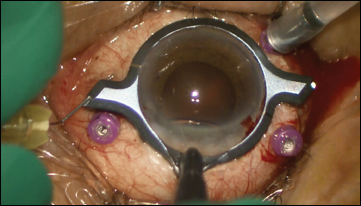
Source: Shin Yamane, MD
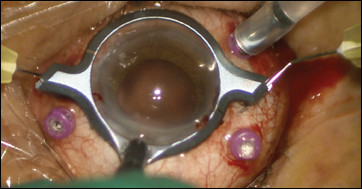
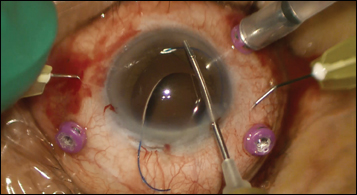

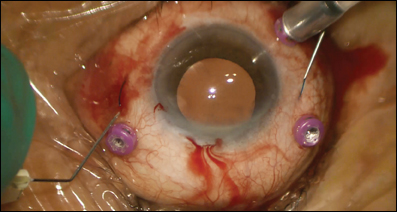
4. Angled sclerotomies made with a 30-gauge thin wall needle through the conjunctiva at 2 mm from the limbus (Figures 1 and 2).
5. Insertion of the leading haptic into the lumen of the needle using forceps (Figure 3).
6. A second sclerotomy made with a 30-gauge thin wall needle at 180° from the first sclerotomy.
7. Insertion of the trailing haptic into the lumen of the second needle while the first needle was put on the conjunctiva (double-needle technique, Figure 4).
8. Externalization of the haptics onto the conjunctiva with the needles (Figure 5).
9. Cauterization of the ends of the haptics using an ophthalmic cautery device (Accu-Temp cautery, Beaver-Visitec) to make a flange with a diameter of 0.3 mm (Figure 6).
10. Fixation of the flange of the haptics into the scleral tunnels (Figure 7).
11. Peripheral iridotomy using the vitrectomy cutter after miosis.
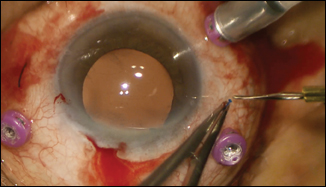

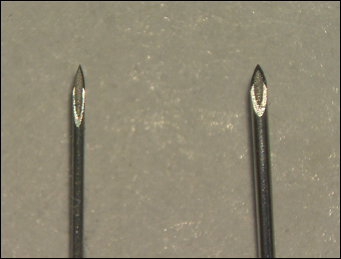

Surgical pearls
1. Thirty-gauge thin wall needle (Figure 8). This needle (TSK ultra thin wall needle) is available in Japan (Tochigi Seiko), the United States (Delasco) and Netherlands (TSK Laboratory Europe). The inner diameter of the needle must be 0.18 mm or more. The outer diameter of the needle should not be larger than the flange of the IOL haptics. A 27-gauge needle is available if the diameter of the flange is more than 0.4 mm.
2. The positional relationship of the wounds. It is appropriate for the wounds, where the IOL is inserted and the site where the 30-gauge needle is inserted, to be in positions that are separated by approximately 90° (Figure 9).
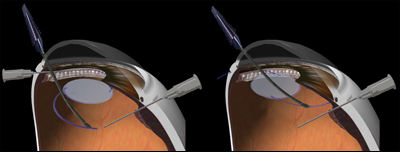
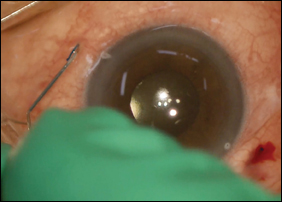
3. Double-needle technique. Placing the leading haptic in the inner cavity of the 30-gauge needle makes the positional relationship of the trailing haptic and the second 30-gauge needle appropriate and facilitates easy insertion. If the leading haptic is pulled out together with the 30-gauge needle, the IOL will rotate in the anticlockwise direction. It is difficult to insert the tip of the trailing haptic into a 30-gauge needle in this situation (Figure 10).
4. The insertion angle of the 30-gauge needle. In order to avoid IOL tilt and dislocation, the haptics must be fixed symmetrically. We have developed a device (not commercially available yet) to stabilize the direction of the needles that will help us to fix the IOL with perfect positioning.
5. Making and fixation of the flange. The cautery should not touch the haptic while cauterizing to avoid adhesion. The haptic should be dry to avoid a twisted flange. The appropriate length of the haptic to cauterize is 0.5 mm to 1 mm. If the size of the flange is too large to insert into the scleral tunnel, the entry site of the scleral tunnel should be enlarged using a 30-gauge needle (Figure 11).
Summary
The flanged IOL fixation technique is simple and minimally invasive and provides firm haptic fixation. Although it is a simple procedure, there are some key points for making this surgery a success.
- References:
- Agarwal A, et al. J Cataract Refract Surg. 2008;doi:10.1016/j.jcrs.2008.04.040.
- Durak A, et al. J Cataract Refract Surg. 2001;doi:10.1016/S0886-3350(00)00638-6.
- Gabor SG, et al. J Cataract Refract Surg. 2007;doi:10.1016/j.jcrs.2007.07.013.
- Hayashi K, et al. Ophthalmology. 1999;doi:10.1016/S0161-6420(99)00504-7 82.
- Kumar DA, et al. Am J Ophthalmol. 2011;doi:10.1016/j.ajo.2010.09.013.
- Sinha R, et al. Eye Contact Lens. 2017;doi:10.1097/ICL.0000000000000287.
- Yamane S, et al. Ophthalmology. 2014;doi:10.1016/j.ophtha.2013.08.043.
- Yamane S, et al. Ophthalmology. 2017;doi:10.1016/j.ophtha.2017.03.036.
- For more information:
- Shin Yamane, MD, can be reached at Department of Ophthalmology, Yokohama City University Medical Center, Yokohama, Japan. 4-57 Urafune-cho, Minami-ku, Yokohama, Kanagawa 232-0024, Japan; email: shinyama@yokohama-cu.ac.jp.
- Edited by Amar Agarwal, MS, FRCS, FRCOphth, director of Dr. Agarwal’s Eye Hospital and Eye Research Centre. Agarwal is the author of several books published by SLACK Incorporated, publisher of Ocular Surgery News, including Phaco Nightmares: Conquering Cataract Catastrophes, Bimanual Phaco: Mastering the Phakonit/MICS Technique, Dry Eye: A Practical Guide to Ocular Surface Disorders and Stem Cell Surgery and Presbyopia: A Surgical Textbook. He can be reached at 19 Cathedral Road, Chennai 600 086, India; email: dragarwal@vsnl.com; website: www.dragarwal.com.
Disclosures: Yamane and Agarwal report no relevant financial disclosures.
